Ultimate Socks Midweight Merino Wool Mens Pairs Ski
The Best Wool and Synthetic Ski Socks of 2022
THE TOP MEN'S AND WOMEN'S SKI SOCKS FOR WARMTH, CUSHIONING, TECH, AND FIT

Trust us, ski socks are worth the investment. They can make or break your time in the mountains. While the best ski socks will never be as crucial as, say, your well-fitting ski boots, they're an important piece of your ski kit, and should not be overlooked. Thick hiking socks might work in a pinch, but if you really want to avoid painfully cold toes, gnarly blisters, and pinched calves, a great pair of ski socks will make all the difference.
We considered merino wool and synthetic ski socks that are best for resort, backcountry, nordic, and ski touring. We've also found that ski socks work like an insulated compression sock for many winter outdoor activities, and can double for cold-weather cycling, running, and hiking, too. To find the best ski socks for men and women, we researched the 10 most loved models out there that feature the best materials and tech. Then we took to the slopes and skin track to test for ourselves. For the sake of your feet, we implore you to read on.
We write mission-driven gear reviews. To find the best gear, we combine expert reviews, everyday user opinions, and rigorous independent trail testing—never native ads or sponsored posts. We are 100% reader-supported and may make a small commission from some qualifying affiliate links. Learn more .

The Best Ski Socks
Smartwool Ski Full Cushion
Read why→

Best Synthetic Ski Socks
Darn Tough Thermolite OTC Padded Cushion
Read why→

Best Lightweight Ski Socks
Smartwool PhD Pro Freeski
Read why→

Best Socks for Ski Touring
Darn Tough Outer Limits OTC Lightweight Ski Sock
Read why→
Ski Socks Comparison Table
| SKI SOCK | AWARD | MATERIAL | THICKNESS | LENGTH/SIZING | SIZES AVAILABLE (BY SHOE SIZE) |
|---|---|---|---|---|---|
| Smartwool Ski Full Cushion Over the Calf Women's Men's | Best Ski Sock | 63% merino wool, 35% nylon, 2% elastane | Medium | 13" over the calf | unisex: 3 - 14.5, women's: 4-12.5, youth sizing |
| Darn Tough Thermolite Snow OTC Midweight Women's Men's | Best Synthetic Ski Sock | 64% Thermolite polyester, 33% nylon, 4% Lycra Spandex | Medium | over the calf | men's 8-14.5; women's 4.5- 11.5 |
| Smartwool PhD Pro Freeski Women's Men's | Best Lightweight | 57% merino wool / 40% nylon / 3% elastane | Light Elite | 14" over the calf | men's 6-14.5; women's 4-12.5 |
| Darn Tough Outer Limits OTC Lightweight Women's Men's | Best Ski Touring Sock | 42% merino wool, 54% nylon, 4% Lycra Spandex (men's); 41% merino wool, 56% nylon, 3% Lycra Spandex (women's) | Light-Medium | over the calf | men's 8-14.5; women's 4-11.5 |
| Wigwam Snow Sirocco Men's | 60% wool, 30% nylon, 9% polyester, 1% Spandex | Medium-Heavy | over the calf | men's 5-15; women's 4-13 | |
| Icebreaker Ski+ Light Women's Men's | 53% merino wool, 44% nylon, 3% Lycra | Light | over the calf | men's 7-14.5; women's 5-11 | |
| Voormi Ski Sock Unisex | Precision-blended merino wool and nylon | Medium | over the calf | men's 3-11+; women's 4-10+ | |
| Dissent GFX Compression Hybrid DLX-Wool Sock Unisex | Polgygiene anti-odor treated hybrid | Medium | over the calf | men's 4-13.5; women's 4.5 -12.5, youth sizing | |
| CEP Winter Ski Compression Socks Women's Men's | 69% Polyaminde, 25% merino wool, 10% spandex | Light | over the calf | 12.5-20" calf circumference59.95 | |
| Fox River Telluride Medium Unisex | 53% acrylic, 27% nylon, 18% Merino/Wool blend, 2% spandex | medium | over the calf | men's 3-14.5, women's 4-12.5 |
SOURCE: Manufacturers
The Best Ski Socks

Best Merino Wool Ski Socks:
Smartwool Ski Full CUshion
Men's and Women's
Material: merino (63%) nylon (35%) elastane (2%)
Thickness: Midweight
Length: 13" over the calf
Sizing: S to XL; men's 3 - 14.5, women's 4-12.5 (shoe sizes), youth sizing
The men's and women's Smartwool Ski Full Cushion Over-the-Calf socks have been a top choice among skiers for years now, and for good reason: they provide an excellent balance of warmth, comfort, and moisture-wicking with lasting durability. They're an easy pick for our best all-around ski sock.
The Smartwool Ski Full Cushion socks are made of a merino blend, with 63% merino wool for maximum temperature regulation and moisture-wicking, and nylon and elastane mixed in for durability and stretch.
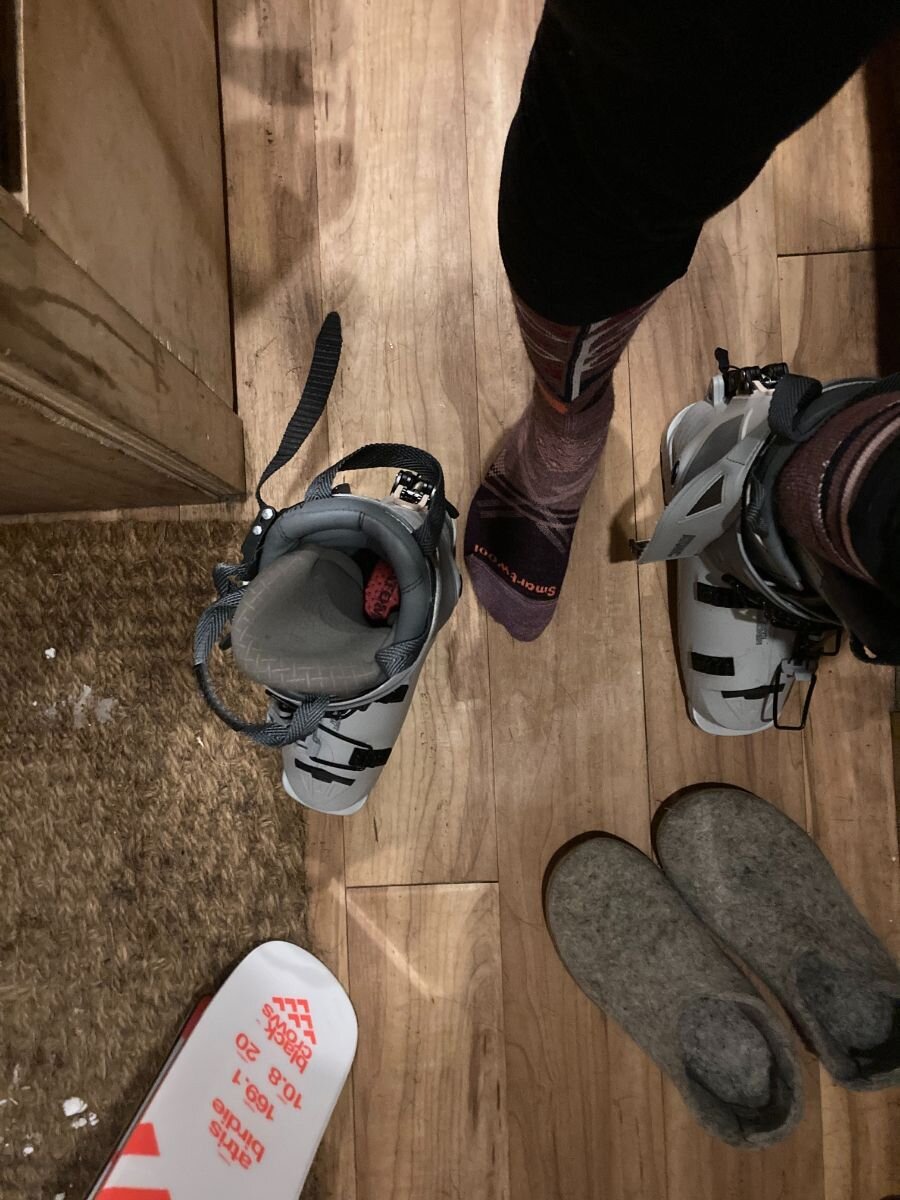
Booting up in the Smartwool Phd Medium Ski Sock. Photo by Stasia Stockwell.
The midweight thickness strikes the right balance between a precise fit and just enough padding and warmth. Smartwool makes ski socks in a variety of thicknesses, but we think the midweight offers the best overall performance for most skiers.
This Smartwool sock has an articulated fit — snug with a thinner weave around the center of the foot and at the ankle that prevents excess material from bunching up in your ski boot. Padding under the heel and ball of the foot adds further comfort and warmth. A bit of extra cushioning in the shin helps to prevent shin bang without being too bulky. Thanks to the merino wool in the fabric, this ski sock manages both moisture and friction well, keeping your feet as warm, dry, and blister-free as possible.
The length of the Smartwool Ski is considered to be an over-the-calf sock, but we find these to fit just a bit shorter than other socks in the review. For shorter skiers, this is an ideal fit since other over-the-calf ski socks reach all the way above the knee for those with shorter legs. However, folks with long legs or particularly wide calves may prefer the fit of other socks, like the Darn Tough Thermolite OTC.
The Smartwool Ski socks are some of the most durable in our review. These socks have been the go-to for our writer for over a decade and we've seen single pairs last that long, too. The merino wool sock construction is sturdy without being cumbersome, and they remain comfortable for full days in the resort and on backcountry tours alike. If you're looking for one excellent and versatile ski sock to do it all and last multiple seasons, look no further than the Smartwool Ski Full Cushion.
Along with our writer's years of experience happily using these socks, they also come highly rated by everyday customers and other expert media outlets. They get high marks at Outdoor Gear Lab, Switchback Travel, and Gear Junkie (see Sources). Dozens of 5-star reviews at places like REI and Smartwool's website have customers complimenting the comfort and durability of these socks.
Compare Prices of the Smartwool Ski Full Cushion Over the Calf Socks
Men's
Women's
Best Synthetic Ski Socks:
Darn Tough Thermolite OTC Midweight
Men's and Women's
Material: 64% Thermolite Polyester, 33% Nylon, 4% Lycra Spandex
Thickness: Medium
Length: Over the calf
Sizing: men's shoe sizes 8 - 14.5 (M to XL) , women's shoe sizes 4.5 - 11.5 (S to L)

Darn Tough socks live up to their name, especially when you consider their unconditional lifetime guarantee. For synthetic socks with exceptional durability, the men's and women's Darn Tough Thermolite Over-The-Calf (OTC) Midweight Ski and Snowboard Sock stands out among the crowd. With a Medium thickness similar to the Smartwool Ski Ful Cushion (full review above), these socks are a great option for an all-around sock for resort skiing.

The Darn Tough Thermolite (left) are longer than the Smartwool Phd Medium (right). Photo by Stasia Stockwell.
The padding on these Thermolite socks is especially good, with ample cushion under the foot and at the shin. There is a nice amount of articulation in the foot to mitigate bulk and bunching in the ski boot, but these are not the most form-fitting socks in our review.
The synthetic Thermolite material does a great job at wicking moisture, and the socks are warm as long as they don't get too wet. While synthetic material dries faster, wool will maintain much of its warmth even when wet. But because the Thermolite socks are all synthetic, it makes them slightly sturdier than their merino wool ski sock competitors. Those whose bodies run warmer may find synthetic ski socks more comfortable than merino wool, too.
The length of these synthetic socks, like all others in this review, is over-the-calf. These socks fit a bit longer than the Smartwool Ski Full Cushions, reaching our 5'2" writer completely over the calf and just at the bend in the knee. Compared to our Best All-Around pick, these socks will fit folks with wider calves or longer legs a bit better.
After several ski days at the resort, ranging from warm and sunny 30-degree days to bone-chilling days in the single digits, these socks did a great job at keeping our feet warm and dry. Great customer reviews and media accolades abound for the Darn Tough Thermolite OTC socks as well. They get high marks at Outdoor Gear Lab (see Sources). Many everyday reviewers at REI and Darn Tough note the warmth, comfort, and durability. Best yet (and worth repeating), every Darn Tough Sock comes with a lifetime warranty, considered among the best in the industry.
Compare Prices of the Darn Tough Thermolite Over-the-Calf (OTC) Midweight
MEN'S
WOMEN'S

Best Lightweight Performance Ski Socks:
Smartwool PhD Pro Freeski
Men's and Women's
Material: 57% merino wool / 40% nylon / 3% elastane
Cushioning: Light Elite
Height: 14" over the calf
Sizing: men's 6-14.5; women's 4-12.5 (shoe size)
Skiers looking for precision fit and performance in their ski socks will find it in the men's and women's Smartwool PhD Pro Freeski. These ultralight socks are made with 57% merino wool blended with nylon and elastane, and they are designed to give you the best fit possible in your ski boot with no unnecessary frills.
Though these are the lightest and thinnest socks in our review, they still have extra padding where it matters most: in the shins to help prevent shin bang, and some in the ankle for added comfort. The design of the PhD Pro Freeski forgoes any cushioning in the toe and heel in order to give a more snug and minimal fit in the ski boot liner.
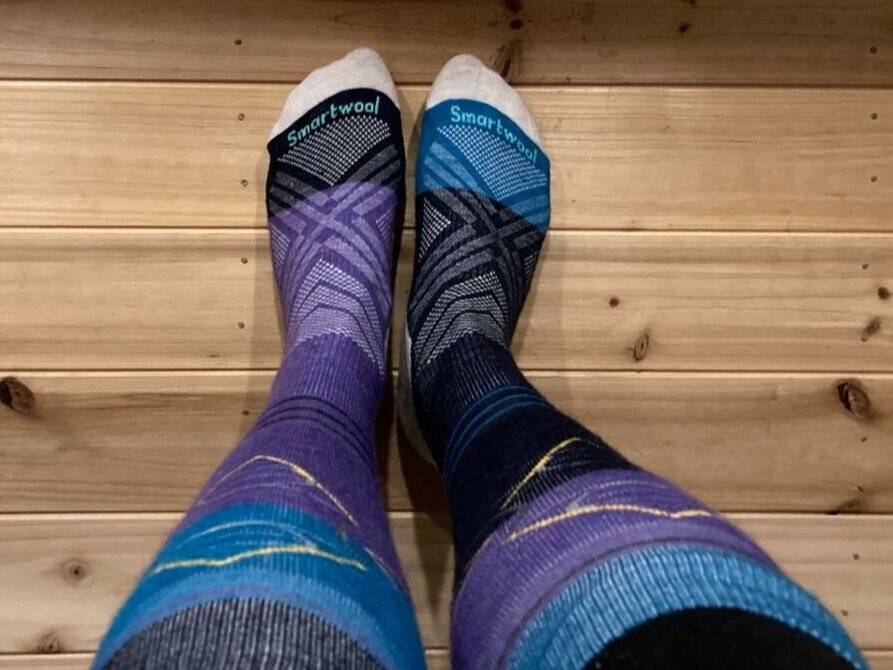
The Smartwool Phd Freeski Pro may be the lightest and thinnest socks in our review, but they still have extra padding where it matters most. Photo by Stasia Stockwell.
While this thin sock isn't quite as warm as others we tested — particularly merino ski socks like the Smartwool Ski Full Cushion or thicker socks like the Darn Tough Thermolite — they still offer a surprising amount of warmth for such a thin sock. Their comfortably snug fit feels like you're not wearing a sock at all — in a good way. And thanks to the Merino wool, this lightweight sock wicks well and stays warm even when damp.
The PhD Pro Freeski socks come up just to the top of the calf, without going over the knee. They offer a nice, compressive fit in the calf, though as the other Smartwool socks in our review, these are not ideal for folks with wide calves.
The men's version worked well for our self-proclaimed large-calved testers. Our testers found that the women's model didn't fit large-calved people as well. We recommend those with larger calves to opt for the men's version.
The Pro Freeski has a tight and tough weave, adding durability to the thin sock design. Because they are on the ultralight side, they are prone to wearing out a bit quicker than Medium weight socks. But for an ultralight sock, we think they are plenty durable, capable of lasting at least a few good ski seasons.
Compare Prices of the Smartwool PhD Pro Freeski Socks
MEN'S
WOMEN'S

Best Socks for Ski Touring:
Darn Tough Outer Limits OTC Padded Light Cushion
Men's and Women's
Material: 42% Merino Wool, 54% Nylon, 4% Lycra Spandex (men's); 41% Merino Wool, 56% Nylon, 3% Lycra Spandex (women's)
Thickness: light-medium
Length: over the calf
Sizing: men's 8-14.5; women's 4-11.5
The men's and women's Darn Tough Outer Limits Over-the-Calf Lightweight socks find a beautiful balance: a snug, precise fit; enough cushion for comfort; and excellent breathability and wicking capabilities. This combination of features — with the added bonus of Darn Tough's notorious durability — make these socks our favorite choice for backcountry ski touring. Out of all the socks we tested, these offered the best performance for constant movement during long days in the mountains.
The Outer Limits socks are woven with 56 percent nylon, 41 percent Merino wool, and a bit of spandex (42% Merino Wool, 54% Nylon, 4% Lycra Spandex for the men's versions). This blend gets the best of both the synthetic and merino wool worlds, offering excellent wicking ability while still fending off odors and staying warm when damp.

We consistently reached for the Darn Tough Outer Limits when heading out for ski tours, thanks to some thoughtful features made just for this type of activity. Cushioning in the shin adds comfort and protection for the downhill while ultralight patches of fabric are placed strategically at the top of the foot, ankle, and calf for maximum breathability during high-effort days. Photo by Stasia Stockwell.
We call the Outer Limits a light-medium cushion. These socks are lighter than the Smartwool Ski Full Cushion (review above) but have more cushion than the PhD Pro Freeski (review above). They fit over the calf without covering the knee and are on the slim-fitting side around the calf.
We consistently reached for these socks when heading out for ski tours, thanks to some thoughtful features made just for this type of activity. Shin padding adds comfort and protection for the downhill while ultralight patches of fabric are placed strategically at the top of the foot, ankle, and calf for maximum breathability during high-effort days. Light padding in the toe and heel provide a touch of comfort without adding any unwanted bulk or bunching. The snug fit matched with the comfortable fabric gives the Outer Limits socks a barely-there feel.
Our tester's feet stayed warm on single-digit dawn patrols without excess sweating or overheating on the uphill, even when the sun came out and temperatures rose. If you're looking for a sock that wicks well and stays warm on high-output days in the backcountry, the Outer Limits will keep your feet happy.
Compare Prices of the Darn Tough Outer Limits Over-the-Calf Lightweight Ski and Snowboard Sock
Men's
WOMEN'S
Honorable Mentions
Several pairs of ski socks came up in multiple sources as excellent options.

WIGWAM Snow SIROCCO
Material: 60% Wool, 30% Stretch Nylon, 9% Stretch Polyester, 1% Spandex
Cushioning: Medium-Heavy
Length: Over the calf
Sizing: men's 5-15; women's 4-13
TheWigwam Snow Sirocco Performance Ski Sock sneaks into our honorable mentions thanks to its popularity as a budget sock. The Wigwam Sirocco wool-blend socks are half the price of most ski socks. For that reason, they get mentions from Wirecutter/New York Times, Gear Junkie, and Switchback Travel (seeSources). While the Sirocco do offer some ski-specific features, like shin padding, they lack the design and precise fit in the foot that other socks in our review have. While the socks that won our awards all have a fairly snug fit with specific weaves and fabric thicknesses throughout the sock, the Wigwam Sirocco isn't much more than a tube sock. Overall, we found in testing that these socks are uncomfortably thick in a ski boot, meaning they're likely to restrict circulation or bunch up in the toe.
When it comes to considering these socks as a budget option, we'd strongly recommend spending a few extra bucks to get better socks. Focus on saving money on other pieces of ski gear, like outerwear, where the price margins are greater and quality budget options exist (see our Best Men's Ski Jackets and Women's Ski Jackets and Ski Pants guides for suggestions). While we didn't love wearing these socks for skiing, they were rather thick and cozy for wearing around the house after a cold day on the slopes.
Compare Prices of the Wigwam Snow Sirocco Ski Sock
Icebreaker Ski+ Light OTC
Men's and Women's
Material: 53% Merino Wool, 44% Nylon, 3% LYCRA
Cushioning: Light
Length: Over the Calf
Sizing: men's 5-15; women's 4-13
The men's and women's Icebreaker Ski+ Light OTC socks offer cozy comfort and warmth for skiing both at the resort and in the backcountry. The merino wool material holds warmth, wicks well, and stays warm when damp.

The Icebreaker Ski+ Light also get high marks from Outdoor Gear Lab and Gear Junkie (see Sources). But While they were close contenders for the best backcountry touring sock, we found after testing that the tight weave on the Darn Tough Outer Limits (review above) to be more durable. The Darn Tough socks have better availability at a range of stores in a range of sizes.
The Ski+ Light OTC socks also run a bit large, which means skiers with small feet or shorter legs may have a tough time finding a good fit without the fabric bunching up. (Those with wider calves might find more luck with these socks.) However, if you're looking for an extra soft pair of merino wool ski socks, these would be a good choice — just consider sizing down.
Compare Prices of the Icebreaker Ski+ Light OTC Socks
MEN'S
WOMEN's
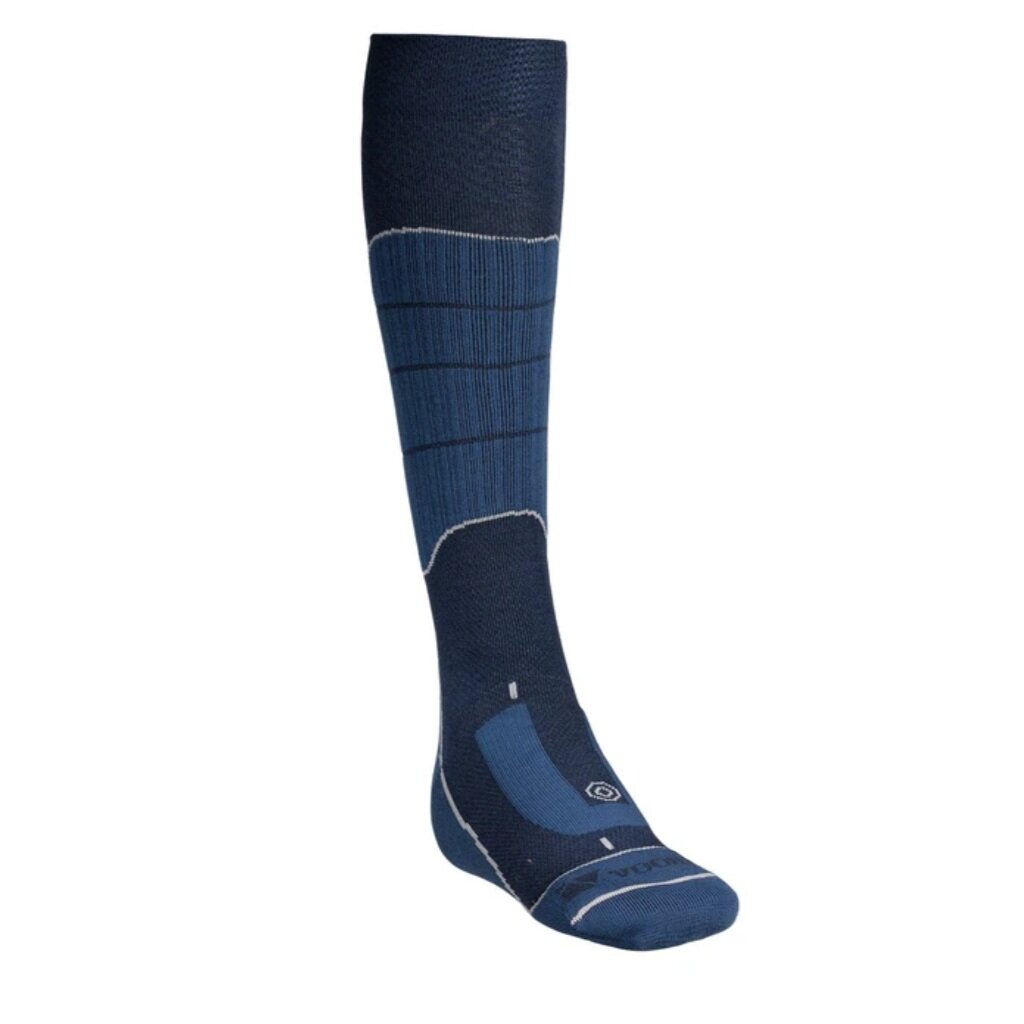
Voormi Ski Sock
Material: Precision-blended Merino wool and nylon
Cushioning: Medium
Length: Over the Calf
Sizing: men's 3-11+; women's 4-10+
The Voormi Ski Sock is a great choice for an all-around ski sock that does it all, from resort laps to long backcountry tours. The tight Merino wool blend weave gives these socks a snug fit with medium thickness and ample warmth and wicking ability. Customer reviews rave about the comfort and quality of these socks. They also get marks from Gear Junkie (see Sources). That's one of the reasons we knew we had to test this sock.
However, the Voormi Ski Socks are on the pricier side for a pair of socks. After testing side-by-side with other socks at lower prices, we felt that they did not outperform our winning models enough to justify the price.
They also run a bit large and have limited sizing options, so skiers with smaller feet won't find a good fit — our tester wears a women's 7.5 street shoe (23.5 mondo size in ski boots) and found the small/medium size to be too big, and there's no option to size down.
However, after testing on a combo of bitter cold days and a handful of backcountry ski tours, these socks proved to be very warm and comfortable.
If the sock fits and you don't mind the added cost, these are a great option.
View the Voormi Ski Sock
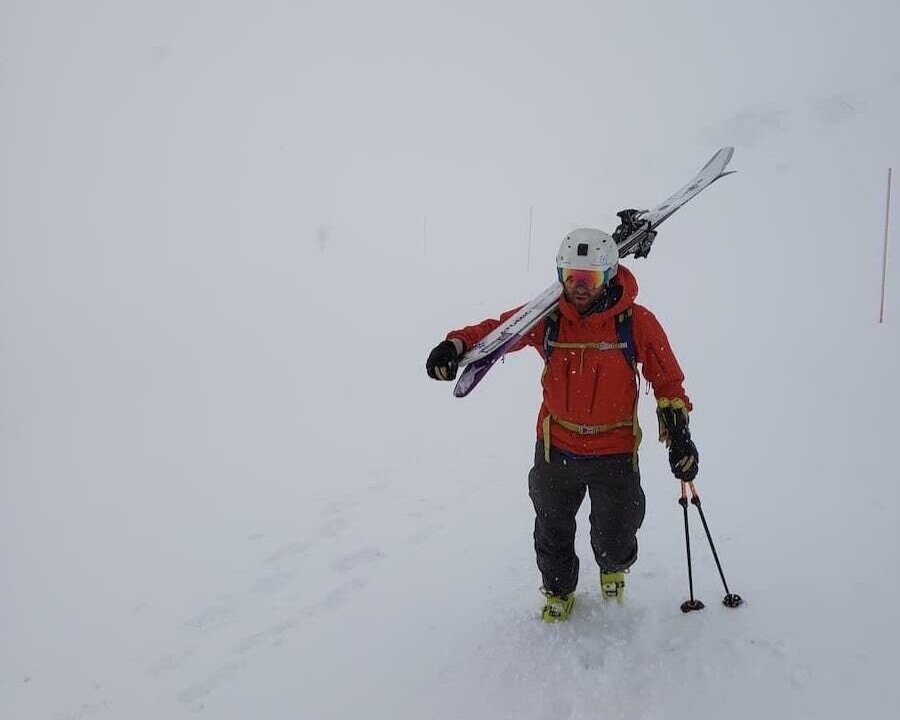
Treeline writer Matt McDonald earning turns. Photo courtesy Matt McDonald.
Do I need Ski-Specific socks?
Skiing socks may seem like an unimportant piece of gear, but there is actually quite a bit of difference in design between ski socks and other kinds of socks. Socks that aren't designed for skiing are likely to bunch up, leading to an uncomfortable fit in your ski boots. Wearing the wrong socks can also restrict your circulation, giving you cold toes. If they're made of cotton or another material that doesn't wick moisture well, you can get cold or damp feet or even blisters. Finding a good pair of ski socks helps to mitigate all of these issues — and if you snowboard, there are even snowboarding-specific socks to make a day on the slopes that much more enjoyable.
In general, ski socks differ from basic winter socks or hiking socks in a few key ways. Ski socks are typically longer — they tend to hit just below the knee. This not only helps with overall comfort — they won't ride down and get bunched up in your boots — but also helps to provide critical protection from "shin bang." Shin bang happens when your shins get bruised or sore from the forward pressure you put on your ski boots, and most good ski socks have cushioning in the front to keep your shins intact.
Ski socks also feature a specific fit in the foot. Where tube socks or a regular sock designed for winter fit uniformly on your foot, ski socks are designed to compress in all the right places. Ski socks work like ergonomic socks — fitting snug around the arch and toes with gentle compression throughout the calves — and prevent any bunching in order to provide maximum warmth, wicking, and overall performance.
Snowboard socks share a lot of qualities with ski socks: both offer gentle compression in the calves and a snug fit overall. But they differ primarily in thickness since snowboard boots don't fit quite as snug as ski boots. Skiers should opt for ski socks instead of snowboard socks to avoid getting socks that are too and uncomfortable. Likewise, snowboarders will find a better match in snowboard-specific socks since they're designed specifically for snowboard boots.

We tested ski socks side-by-side to comparatively understand what makes them different and what makes one sock better than another. Photo by Stasia Stockwell.
What to look for in a ski sock
Design, material, and fit are the three primary factors to consider when buying ski socks. We go into all three of these criteria in our How to Choose section below. We'd also recommend reading these guides from REI Expert Advice and Evo How to Choose Ski Socks for more background information.
Good ski socks should have cushioning in the right places — like the shin and the heel — without being too thick or restricting circulation. Ski socks should also be made of a moisture-wicking material that stands up to seasons of use. This can be a synthetic material, like nylon, or natural fibers, like Merino wool. Lastly, be sure that your ski socks fit you well, especially in the toe. You want them to be snug, so there's no extra fabric to bunch up and cause discomfort in your boots.
The great thing about good ski socks is that — while you don't want to use anything other than ski-specific socks for skiing — ski socks can be versatile to use on anything from winter hikes and snowshoeing and even cold-weather cycling.
Note: Our writer and tester wears a 7.5 street shoe and 23.5 size ski boot and found all of our award picks to fit true to size based on each brand's sizing recommendations.

Close up of the padding for shin bang. Photo by Stasia Stockwell.
How to Choose Ski Socks
Material: Wool vs. Synthetic
The ski socks in this review are made of strategic blends of materials, including Merino wool, nylon, and other synthetic materials. Some are all synthetic, while some are mostly wool, and each type has specific advantages.
Synthetic fabric often offers excellent moisture-wicking capabilities but won't stay as warm as wool if they get wet, while Merino wool balances wicking with warmth very well and has the added bonus of being odor resistant.
Many of the ski socks in our review have a strategic blend of merino wool and synthetic fibers in order to gain the benefits of both materials. With the exception of the all-synthetic Darn Tough Thermolite, all of our award picks for ski socks are a blend of merino wool and synthetic materials, though the percentage of materials differs for each one.
One material that you won't find in a good pair of ski socks is cotton. While cotton socks can be plenty cozy for lounging in, you'll want to opt for synthetic or merino wool socks for skiing. Cotton retains moisture and gets cold when wet, meaning that you're likely to get damp, cold, and blistered feet when skiing if you've got cotton socks on.
Thickness and Cushioning
Generally, you don't want ski socks to be overly thick. You'll find that ski socks often come in different thicknesses (like light, medium, and heavyweight). Ski socks that are a medium or heavyweight will keep your feet warmer, but only as long as they don't restrict circulation. If your ski socks are so thick that they take up too much space in your ski boot and cut off your circulation, they will actually make your feet colder. This is why medium and lightweight ski socks tend to perform best. A lighter, thinner ski sock that keeps the blood pumping through your toes will keep your feet much warmer than a plush, thicker sock that barely fits into your boots. Always cold? See below for Tips on Keeping Feet Warm.
It should be noted, however, that while there is a general standard for how your ski boots should fit, certain folks may have personal preferences. Particularly aggressive expert skiers occasionally opt for a more snug-fitting boot (despite the tradeoff of comfort and potentially limited circulation), and will likely want light or thin ski socks. Resort skiers and those new to the sport may prefer comfort over performance and choose boots with more room; in this case medium and heavier-weight ski socks could work well. We strongly recommend finding a local shop with a good boot fitter to assist you. And if your boot fits right in the sweet spot, then light and medium weight socks are the way to go.
The cushioning in ski socks is strategically placed in order to give you the extra padding where you need it without cutting off your circulation. The cushioned areas are in the shins (to help prevent shin bang) and in the heel (to add comfort and keep your heel from lifting or moving around in the boot). Many ski socks will also have some cushioning in the toe for added comfort and warmth. It's worth trying them on with your ski boots to see what amount of cushioning and thickness fits best. With ski socks, there is rarely any cushioning or extra material in the arch and top of the foot for the sake of breathability, wicking, and a precise fit.
Length and Fit
Ski socks should come up to the calf or just under the knee for maximum performance. They should fit snug enough at the top so they don't ride down, but not so tight that they cut off your circulation. Ankle-height socks should always be avoided, as they lack the protection and performance that a pair of full-length ski socks offer and they'll bunch up and be uncomfortable. Aside from length, you'll want to make sure that the socks fit well in the foot and toe. They should be snug without any loose fabric that could bunch up in your boots.
Seamless Toe
A sock with a seamless toe will help reduce irritation and blisters. Seams can also cut off blood circulation, so a seamless toe will eliminate that problem.

Comparing the men's (size large) and women's (size small) Smartwool Ski Full Cushion socks side by side. The men's version isn't noticeably wider around the calf. Photo by Stasia Stockwell
What's the Difference Between Men's and Women's Ski Socks?
There are often some key differences in the design of men's sock and women's ski socks. Primarily, the design on a men's sock will be slightly longer and a touch skinnier at the top of the calf while women's socks will fit a bit shorter and wider to accommodate for shorter legs and wider calves.
We compared the men's and women's Smartwool PhD socks side-by-side and didn't find a noticeable difference between the calf size. After scouring customer reviews of multiple retailers, we didn't find everyday users complaining about poor fit with these socks. However, our self-described "larger calved" testers found the men's Smartwool to fit well, whereas our self-described "larger calved" testers found the women's to feel tight.
Our takeaway from this experience is that even with gear as "simple" as socks, it's important to look at sizing charts to get the right size AND to try it on before skiing. We recommend ordering from companies that have easy return programs like REI.com, which are free to return to a store for up to a year. Smartwool has a stellar free returns program that includes a free shipping label. Darn Tough's return policy, as well as the 366-day return policy at Evo.com, and Backcountry.com's return guarantee are all easy to use, but you'll have to pay shipping.
Treeline Review recognizes that there are more genders than just men and women but works within the reality that clothing sizes and shapes are categorized this way. Choose the sock that best fits and feels comfortable to your body, regardless of how the brand may have labeled the item.
Ski Socks vs. Snowboard Socks
Because ski and snowboard boots are so different, there are actually some important differences between ski and snowboard socks.
Because ski boots have a bit more of a precise fit than snowboarding boots, you'll want your socks to match your boots.
Ski socks aren't typically quite as thick as snowboard socks, and they'll have cushioning in different places, like in the shin and heel. Snowboard socks will have more overall cushion throughout the sock to echo the looser fit of snowboarding boots.
Should I get Compression Ski Socks?
Athletes sometimes use compression socks in order to help with blood flow and mitigate muscle soreness. Skiers who want these benefits in their socks may enjoy compression ski socks from brands like CEP or Dissent Labs.
While they'll be more expensive than regular ski socks, if you're looking for maximum performance and recovery you might want to consider compression ski socks.

Snowboarders should opt for snowboard-specific socks, which tend to fit snowboard boots better. Photo courtesy Zach Davis.
Should I get Heated Ski Socks?
There are ski socks out there made with battery-powered heat elements that are meant for keeping your feet as warm as possible. However, the design of these socks often makes them cumbersome and a bit uncomfortable. Plus, a heated ski sock is several times more expensive than regular a ski sock. While this could be an option for skiers with chronically cold feet or conditions like Raynaud's syndrome, we find boot warmers to be a better solution than heated socks. If your feet run cold, see our advice in the next section below on other ways to keep your feet warm.

How to keep feet warm when Skiing
Tips for Skiers with chronically cold feet
There are a few key contributing factors if you have chronically cold feet when skiing. Some folks may simply have better circulation than others, and those with somewhat poor circulation in their feet are much more likely to suffer from cold feet when skiing. But there are a number of things you can address to make your runs a little warmer.
The first thing to consider if you get cold feet when skiing is boot fit. Your ski boots should be snug but shouldn't be so tight that they cut off circulation or cause pain in any part of the foot. While this can certainly happen if your boots are too small, it can also happen if your boots are too big and you're compensating by buckling them too tight. The best way to make sure your ski boots fit is to go to a good, local shop and have them fit you for boots.
Of course, your socks could also be a major reason your feet are cold. Make sure your socks hit the right balance of thickness — insulating but not cutting off circulation — and ensure they fit well so you don't have extra fabric bunching up and causing pressure points.
If your boots fit well and you've got the right socks but you still suffer from cold feet, there are a few things you can do to help your toes stay toasty on the slopes.
Never start out with cold boots!
Be sure to bring your boots inside the night before skiing; don't leave them in the car or garage. Better yet, set them by a heating vent or fireplace (close but not too close!) before putting them on to make sure your liners are nice and warm. Another great option for starting out with toasty boots is to keep them by the heating vents in your car if you're driving to the resort.
While you could remove your boot liners from the shell to warm them in a pinch, this usually requires more effort than it's worth. Your boots should be sufficiently warm without removing liners if you store them inside overnight and keep them by a heat source (whether it's your car's vents or otherwise) before putting them on.
Manage your boot buckling
Make sure your boots are tight enough to keep your feet from moving around, but not so tight that they cut off your circulation. There's no need to crank your buckles down before you start skiing, so keep them loose until you're headed downhill for maximum blood flow. Unbuckling your bottom buckles when you're riding the chairlift and then clipping them down at the top can also help increase circulation.
Toe warmers
While there are single-use warming packets made specifically for boots, we find that they almost always do more harm than good. Not only do they make your ski boots uncomfortable, but they can also decrease your circulation by taking up space in your boot and causing too much compression in the front of your foot. Beyond that, they're not likely to get very warm, since there isn't much oxygen in your ski boots to help the chemical reaction along. Overall, we would strongly recommend against using these — instead, opt for good socks, and make sure your boots fit properly.
Ski boot warmers
You can buy electric boot warmers for your ski boots that use a battery pack to circulate warmth through your boot liners. They add a little extra weight and some extra cost to your ski setup but can be a real help if your cold feet won't warm up. (Note: You'd only want to use these battery pack boot warmers for resort skiing and never for the backcountry. They add too much weight and bulk for ski touring and your feet are likely to stay plenty warm while you're climbing uphill anyway.)

Putting on ski socks in the back of the truck. Photo by Josette Deschambeault.
How we researched and tested
We scoured media and customer reviews to find the most popular and top performing ski socks on the market. We analyzed reviews from Outdoor Gear Lab, Gear Junkie, Switchback Travel, Wirecutter/New York Times, and Powder Magazine (See Sources). From there, we compiled a list of 11 socks that received accolades from multiple editorial reviews.
After narrowing down our choices based on our criteria, we took the top 7 contenders to the slopes to test them for ourselves.
We spent dozens of days both at the resort and ski touring in the backcountry, testing the different models for warmth, comfort, performance, and durability. The result is a comprehensive review of the best ski socks out there.

The author in her natural habitat. Photo by Tom Callaghan.
Author's Expertise: Why You Should Trust Us
A true mountain dweller, Stasia feels far more at home on a high alpine ridge than on a busy city street. She's worked as a backpacking guide in southeast Alaska and has written for outlets like BACKPACKER, REI Co-op Journal, and The Dyrt, among others. Stasia is a lifelong skier, mountain biker, and trail runner who's passionate about lowering barriers to entry for outdoor sports. She hopes to inspire people to love and respect the wild natural world through her work.
Raised in the mountains of northern Utah and now based in Breckenridge, Colorado, she has skied an average of 50 days a year since she could walk. She has over six seasons of backcountry skiing experience under her belt, having ski toured in places like southeast Alaska, northern British Columbia, Japan, California, and her home in the Rockies. She's spent time working as an outdoor guide in southeast Alaska and has also received her AIARE Level 1 certification. Stasia uses these years of experience to inform her ski gear reviews.
Stasia's other stories at Treeline Review include:
-
Best Climbing Skins
-
How to Start Backcountry Skiing
-
Best Beginner All Mountain Skis
-
Best Women's Ski Jackets
-
Best Women's Ski Pants
-
Best Women's Mountain Bike Shorts
-
Best Women's Running Shorts
-
Best Bike Racks
-
Best Travel Backpacks
Sources

We researched 24 of the most popular women's ski jackets and then tested to find the best hardshells, insulated jackets, 3 in 1 ski jackets, and ski jackets for layering. We consider hoods, pockets, waterproofing, windproofing, powder skirts, and seam sealing for resort, backcountry, extreme cold, and budget skiers.
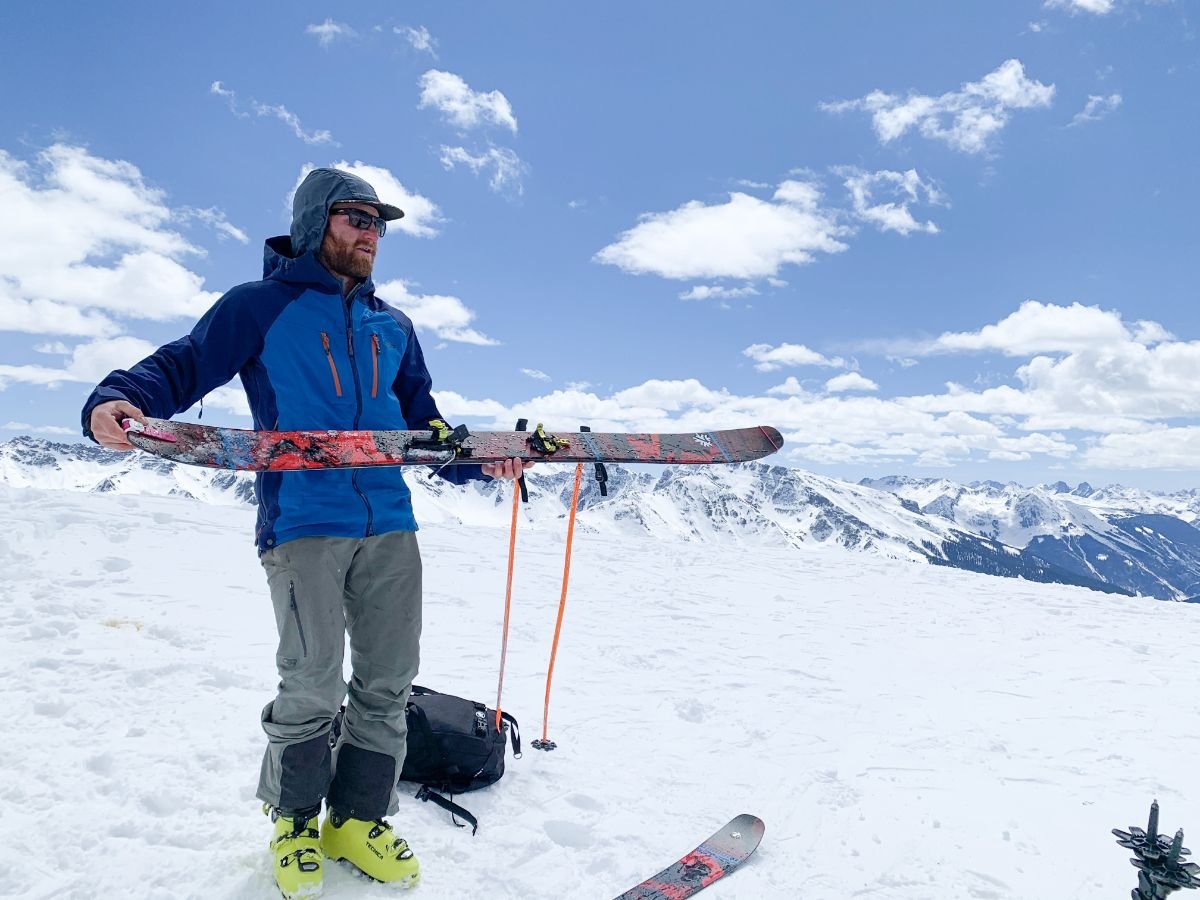
We reviewed 27 men's ski jackets to find the 5 best hardshells, backcountry, insulated, 3-in-1, sub-$300, and waterproof coats. Here are our top rated winners.

A review of the best men's and women's merino wool and synthetic ski socks, factoring in tech, cushioning, fit, length, and warmth for winter's extreme cold.

Looking for a way to stay upright in icy conditions? Sure-footed traction in snow and ice allows you to carry your outdoor life into the shoulder seasons and beyond. We field-tested 8 of the most popular models in Crested Butte, Colorado.

Not all running leggings and tights are created equal; that's why we thoroughly researched and tested this critical piece of gear for ourselves to find the best options for winter runners everywhere.
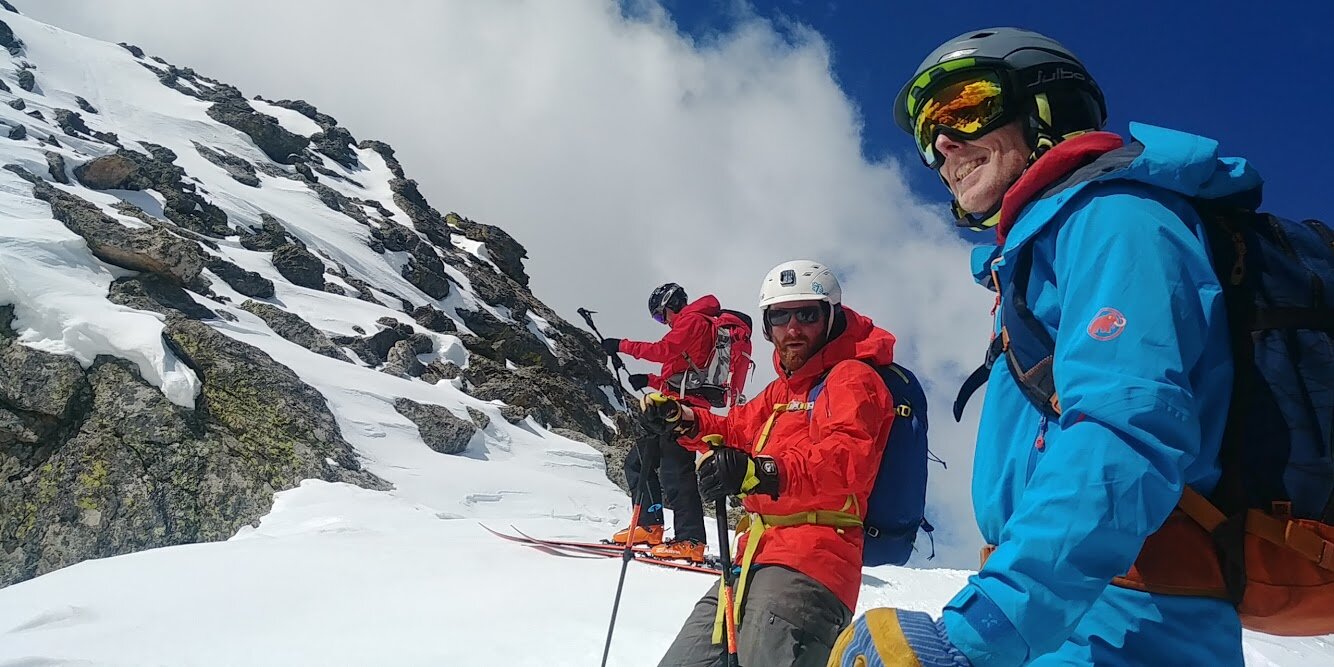
We researched 12 of the most popular MIPS ski helmets by Smith, Pret, Giro, and POC to find the best ski helmets for safety/preventing concussions, backcountry skiing, resort skiing, budget and teenagers, and Bluetooth and audio capability.

We tested the top women's winter boots for ice and snow from Maine to Alaska. We review the best boots for warmth, water resistance, fit, comfort and traction

We waded through the dozens of beginner and intermediate ski models to find the best all-mountain skis. Read our guide for the best beginner all-mountain skis, with picks from Volkl, Rossignol, Blizzard, Head, Salomon, & Nordica. See our picks for best all-around beginner skis, best powder skis, best women's skis, and more.
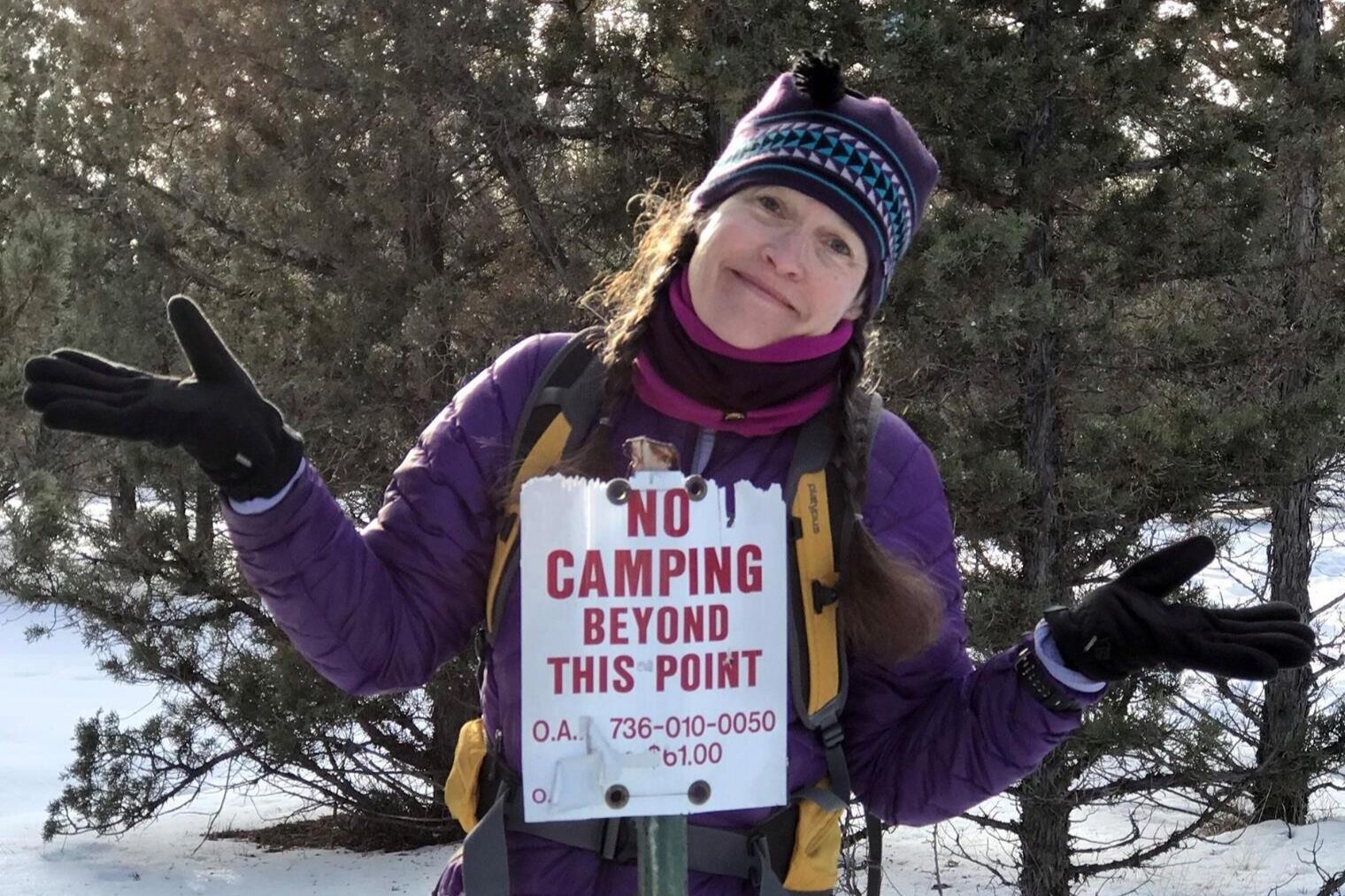
We researched the 100 most popular winter gloves, liner gloves, heated gloves, and mittens to find the best gloves for running, cycling, extreme cold, and touchscreen usage. We found thin, lightweight, unbulky gloves with great dexterity.
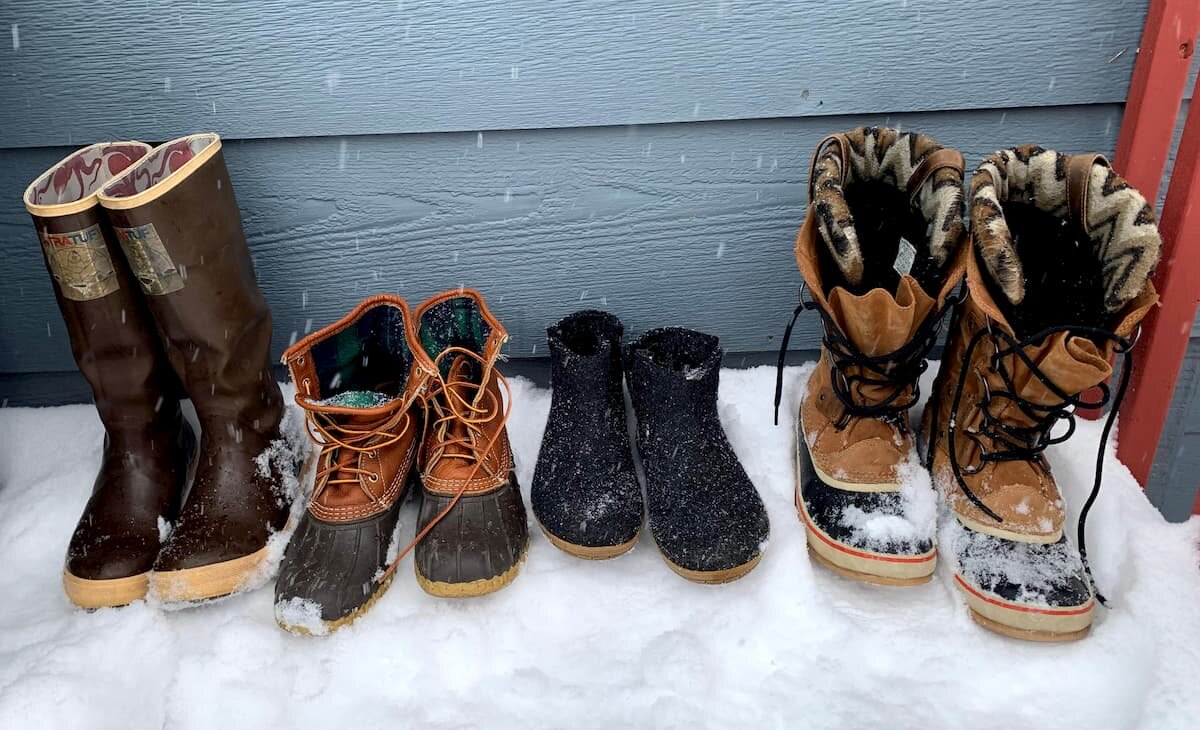
Tested on ice and snow from Maine to Alaska, here's our review of the best men's winter boots for warmth, water resistance, fit, comfort and traction.
Ultimate Socks Midweight Merino Wool Mens Pairs Ski
Source: https://www.treelinereview.com/gearreviews/best-ski-socks